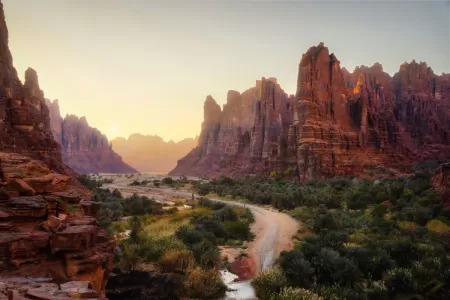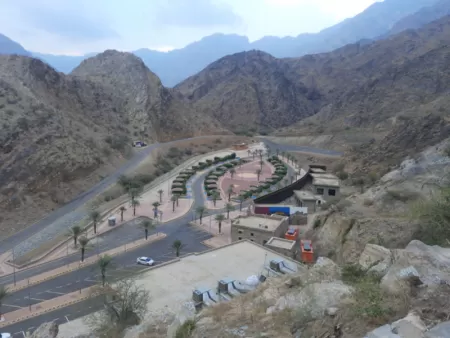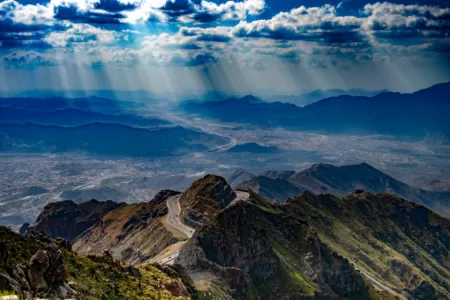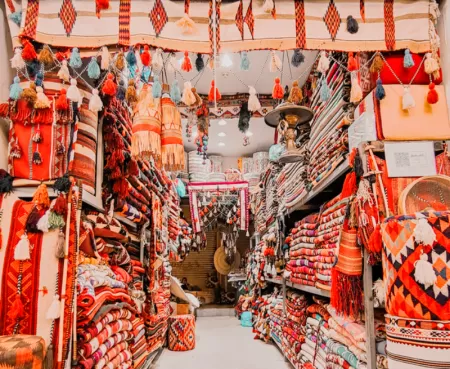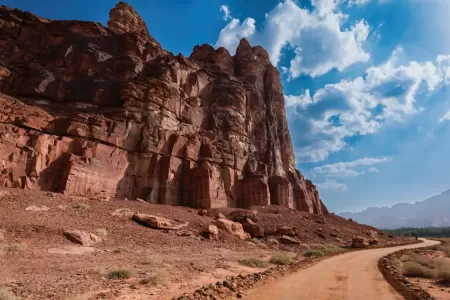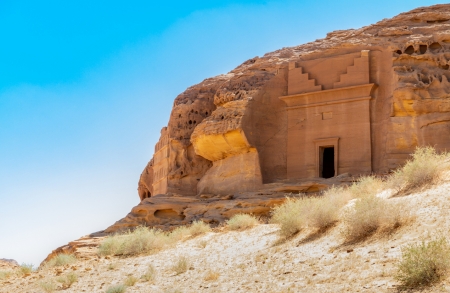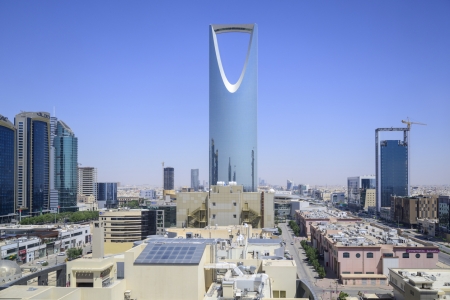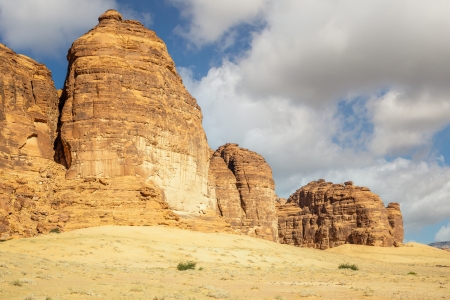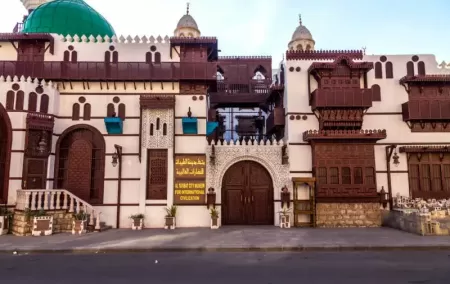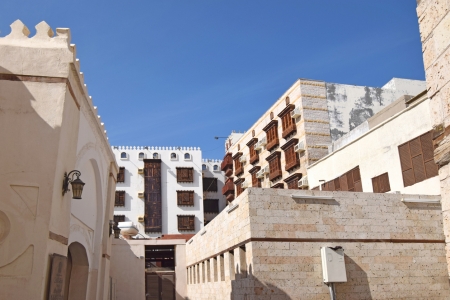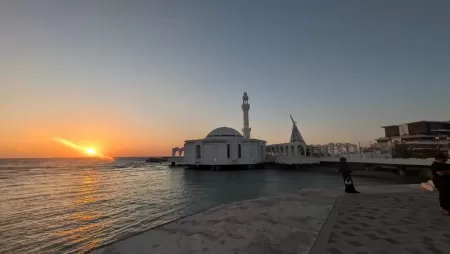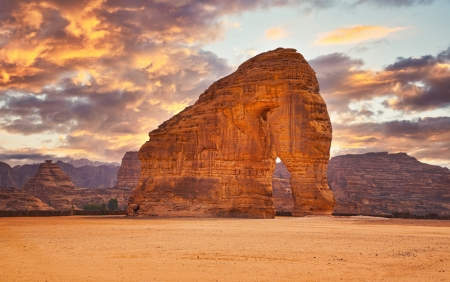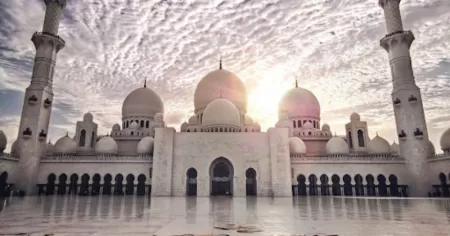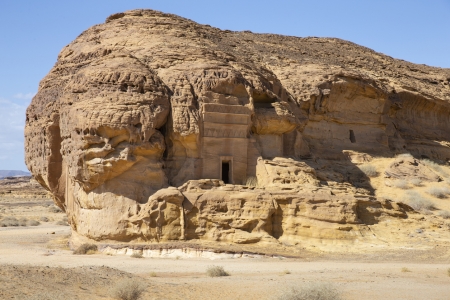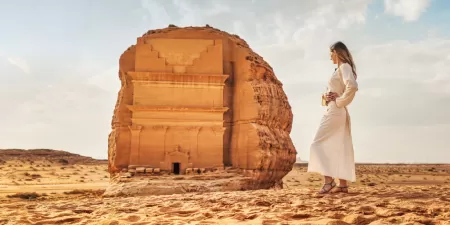Where Walls Tell Stories: Rijal Almaa's Living Art
Rijal Almaa, Saudi Arabia: A captivating 900-year-old historical village in the Asir mountains, renowned for its unique stone and clay "gingerbread" architecture. This UNESCO-nominated site showcases exquisite "Al-Qatt" art and the vibrant culture of the "Flower Men," offering a profound journey into Arabian heritage.
.webp)
Perched dramatically along the mountainous terrain of Saudi Arabia's Asir province, Rijal Almaa emerges as a captivating historical wonder that has witnessed nine centuries of Arabian heritage. This ancient village, positioned roughly 50 kilometers west of Abha, once commanded the vital trade arteries that bound Yemen to the Levant, weaving through the sacred cities of Mecca and Medina.
The settlement's extraordinary stone and clay architecture has earned it the endearing moniker of Saudi Arabia's "gingerbread village"—a testament to the whimsical yet sturdy construction techniques that have defied time itself. Wandering through this remarkable enclave reveals approximately 60 multi-story edifices, several ascending to impressive eight-floor heights that seem to pierce the mountain sky.
Within these towering structures lies a treasure trove of cultural artistry. The Heritage Village presents the exquisite "Al-Qatt" decorative tradition, where local women have masterfully crafted harmonious patterns and vibrant colors that dance across interior walls. Meanwhile, the village museum stands as a guardian of memory, safeguarding over 2,000 precious antiquities and historical documents across nineteen carefully curated sections.
Recognition has followed this architectural marvel remarkably. The village claimed the prestigious Prince Sultan bin Salman Prize for Urban Heritage in 2017, later earning distinction from the UNWTO as one of the world's finest tourism villages. Most significantly, Rijal Almaa currently awaits final consideration for UNESCO World Heritage status—a designation that would formally acknowledge its extraordinary cultural and historical value to humanity.
History and Origins of Rijal Almaa
Tracing the ancestral threads of Rijal Almaa reveals a settlement whose roots extend nearly a millennium into Arabia's past, establishing it among the Kingdom's most enduring, continuously inhabited communities. Long before the modern Saudi state took shape, this village had already carved its identity into the Asir region's historical landscape.
A 900-year-old trade hub
Historical records place Rijal Almaa's founding approximately 900 years ago, though scholarly investigations suggest the settlement may actually span closer to 1000 years. The village's initial prosperity stemmed from a fortuitous geographical advantage—its strategic perch within the mountainous terrain of southwestern Arabia created natural opportunities for commercial enterprise. Here, merchant caravans found respite, conducted exchanges, and established business relationships that would span generations.
Wealth gradually accumulated within these mountain walls as Rijal Almaa evolved from modest beginnings into a formidable regional powerhouse. Traders increasingly recognized the settlement's significance along established caravan routes, and this growing acknowledgment fueled the village's steady ascent to commercial prominence across Arabia and distant lands.
Connection to Yemen, Mecca, and the Levant
Geography bestowed upon Rijal Almaa an exceptional advantage—its location formed a natural nexus linking southern Yemen with the northern territories of the Levant. The village simultaneously served as an essential waystation for travelers bound for the holy cities of Makkah and Madinah.
This positioning at the intersection of major thoroughfares transformed Rijal Almaa into far more than a simple rest stop; it became a cultural crossroads where civilizations converged. Merchant caravans bearing precious incense and aromatic spices made regular stops here, fostering an environment where diverse traditions, languages, and customs merged and evolved.
Role in regional commerce and pilgrimage
Economic influence radiated from Rijal Almaa far beyond its immediate vicinity. The settlement operated as a bustling commercial nexus where traders from coastal harbors and highland territories regularly convened. These merchants arrived bearing varied treasures—exotic spices, intricate jewelry, and countless other valuable commodities.
Religious significance paralleled commercial importance, as Rijal Almaa supported crucial pilgrimage corridors stretching across Saudi Arabia from north to south. This dual identity—serving both profit-seeking merchants and faith-driven pilgrims—amplified the village's historical significance throughout the region.
Historical records reveal Rijal Almaa as an active participant rather than a mere observer of major events, including a significant uprising against Ottoman authority during the 19th century. This episode illuminates the fierce independence and regional authority that defined the village's character across its extensive history.

Architectural Marvels of Rijal Almaa Village
The built environment of Rijal Almaa presents an architectural vocabulary entirely unique within the Kingdom's landscape. Nestled against the lush Asir mountains, these ancient structures reveal centuries of refined building mastery that continues to astonish contemporary observers.
Multi-story stone and clay buildings
Each edifice within Rijal Almaa represents a masterclass in traditional construction methodology, utilizing stone, clay, and wood in harmonious combination. These towering achievements demonstrate sophisticated engineering principles developed long before modern architectural theory. The village's crown jewel, Al Elwan Fort, commands attention as the settlement's most prominent structure.
Construction methodology reveals remarkable ingenuity. Rather than relying on conventional support systems, master builders created fortified walls of stone and clay capable of bearing tremendous vertical loads. The practical arrangement placed livestock and storage facilities on ground levels, while residential quarters occupied elevated floors—a strategic design that enhanced both daily functionality and defensive positioning against potential threats.
The 'gingerbread village' nickname
This enchanting designation stems from the buildings' whimsical appearance, which evokes fairy-tale imagery against the mountainous backdrop. The organic emergence of structures from their rocky foundation creates an almost mystical quality that captivates first-time visitors. Contemporary preservation efforts seek to maintain this distinctive architectural character while fostering sustainable economic development.
Al-Qatt Al-Asiri art and its significance
The interiors of these stone giants harbor another layer of cultural richness. Al-Qatt Al-Asiri wall decorations transform living spaces into artistic sanctuaries through the skilled hands of local women. UNESCO's 2017 recognition of this art form as Intangible Cultural Heritage acknowledges the spontaneous geometric patterns and symbolic motifs applied over white gypsum foundations. The palette draws from nature's own colors—verdant greens, pure whites, golden yellows, and vibrant reds.
Colorful wooden windows and doors
Against the neutral stone facades, wooden architectural elements provide striking chromatic punctuation throughout the village. These carefully crafted features echo the same color palette found in Al-Qatt artistry, establishing visual continuity between exterior and interior design philosophies. The interplay between earthen building materials and these colorful accents creates Rijal Almaa's instantly recognizable aesthetic signature.

Cultural Identity and Traditions
The soul of Rijal Almaa pulses not merely through its ancient stones but through the living traditions that have endured across generations. Here, cultural practices weave themselves into daily existence, creating a tapestry of customs that reveals the true essence of this mountain settlement.
The Flower Men and their attire
The Qahtani tribesmen of this region have earned the enchanting title of "Flower Men"—a designation that speaks to one of Arabia's most distinctive cultural traditions. For over two millennia, these men have adorned their hair with aromatic garlands crafted from marigolds, thyme, basil, and various mountain herbs. These fragrant crowns serve dual purposes: aesthetic beauty and practical medicine, particularly offering relief from altitude-induced headaches.
Their striking appearance extends well beyond these floral decorations. The traditional "futa"—vibrant calf-length garments featuring bold horizontal stripes—creates an immediately recognizable silhouette. Henna transforms their hair and beards into brilliant auburn shades, while ceremonial daggers rest securely at their waists. This ancestral dress code has remained virtually unchanged, representing a living connection to ancient Arabian heritage.
Traditional food like Haneeth
Culinary artistry finds its pinnacle in Haneeth, a slow-cooked lamb preparation that embodies the region's gastronomic wisdom. The process begins with selecting premium livestock that have grazed on aromatic herbs beneath Sidr, Qarad, Samar, and Talh trees. Traditional preparation involves wrapping the meat in "Marakh" or "Sal" plants before placing it in a "mahnaz"—an underground sand pit where embers provide gentle, sustained heat for two to three hours.
This remarkable dish transcends mere nourishment, particularly when served alongside fragrant rice or warm bread, sometimes sweetened with local honey. Throughout the coastal areas near Rijal Almaa, Haneeth functions as a symbol of hospitality and celebration, bringing communities together during significant occasions.
Community life and local customs
Cultural preservation manifests most vividly during the annual Flower Men Festival, established in 2019 to showcase the region's artistic heritage. Nine distinct tribes gather to perform traditional displays while cutting-edge 3D light projections illuminate the ancient architecture, creating a spectacular fusion of past and present.
Musical traditions remain deeply embedded in community identity. Performances feature rhythmic hand-clapping, melodic chanting, and energetic movements accompanied by flutes, horns, and a three-stringed instrument reminiscent of the classical oud. Many families continue ancestral nomadic patterns, migrating to cooler mountain tents during summer months.
Visitors seeking authentic cultural encounters can participate in hands-on workshops focusing on traditional pottery and weaving techniques, gaining direct insight into the artistic heritage that defines Rijal Almaa's cultural landscape.
Customize Your Dream Vacation!
Get in touch with our local experts for an unforgettable journey.
Plan Your TripTourism and Preservation Efforts
Recent decades have witnessed Rijal Almaa's evolution from a quietly preserved historical enclave into a celebrated destination where heritage meets modern tourism infrastructure. Government initiatives and strategic private investments have created a delicate balance between cultural preservation and accessible visitor experiences.
Rijal Almaa Museum and its collections
The Al Elwan Fort, a fortress that has stood sentinel for over four centuries, now serves as the village's primary museum. This remarkable repository safeguards more than 2,000 carefully curated antiquities and documents across nineteen distinct sections. Each exhibit tells part of the greater story—traditional garments, intricate jewelry, kitchen implements, ancient manuscripts, working tools, and historic weapons, all gathered through the dedicated efforts of local residents. The fortress walls themselves become part of the exhibition, displaying the UNESCO-recognized Al-Qatt Al-Asiri art form that represents centuries of female artistic expression. Museum hours extend from 9:00 am to 9:00 pm daily (closing during prayer times) with admission priced at 20 SAR (approximately $5.30).
UNESCO World Heritage nomination
Rijal Almaa's position on UNESCO's tentative World Heritage list represents years of careful documentation and international recognition. This prestigious consideration followed the village's triumph in securing the Prince Sultan bin Salman Award for Urban Heritage in 2007, distinguishing itself among 175 nominations from 75 countries worldwide. UNESCO authorities have drawn comparisons between Rijal Almaa and France's renowned Mont Saint Michel, recognizing both as exceptional examples of architectural preservation within extraordinary geographical settings.
Soudah Peaks tourism project
The ambitious Soudah Peaks development project promises to redefine mountain tourism across this remarkable region. Soudah Development, operating under the Public Investment Fund, has designed a luxury destination that spans both Soudah and Rijal Almaa territories. The master plan encompasses:
- Six carefully planned zones: Tahlal, Sahab, Sabrah, Jareen, Rijal, and Red Rock
- Construction targets of 2,700 hotel rooms alongside 1,336 residential units by 2033
- Meticulous restoration of historic structures, including Sheik's Fortress, Bee House, and Hamidiyah Fortress
Project architects anticipate welcoming over 2 million annual visitors by 2030 while generating 10,700 employment opportunities across direct and supporting industries.
How to reach Rijal Almaa from Abha
Rijal Almaa's location, approximately 45-50 kilometers from Abha, offers visitors several practical approaches:
- Private vehicle: Car rental provides maximum flexibility for exploring the region. Mountain routes require 1-1.5 hours of driving time.
- Alternative routing: Less confident mountain drivers may prefer the extended Dhila Road route, which adds time (approximately 2 hours) while offering gentler terrain.
- Local transportation: Hiring experienced local drivers proves particularly valuable for afternoon journeys when mountain traffic increases.

Conclusion
Standing at the threshold of this remarkable exploration, Rijal Almaa reveals itself as far more than an ancient settlement frozen in time. This extraordinary mountain village embodies the very essence of cultural continuity, where centuries of human ingenuity have created a living tapestry that continues to unfold before curious eyes.
Each weathered stone wall and intricately decorated interior tells stories that span generations, offering visitors a profound connection to the rhythms of Arabian life that have persisted across millennia. The village serves as a masterclass in how communities can maintain their authentic character while embracing recognition and responsible development.
What makes this destination particularly compelling lies not merely in its physical structures or museum collections, but in its ability to transport visitors into a world where traditional craftsmanship, ancient trade routes, and time-honored customs converge. The experience becomes deeply personal, whether observing the delicate artistry of Al-Qatt patterns, witnessing the vibrant traditions of local festivals, or simply absorbing the atmosphere of this mountain sanctuary.
Modern preservation initiatives demonstrate how heritage sites can flourish without losing their soul. The careful balance between accessibility and authenticity ensures that future explorers will encounter the same sense of wonder that greets today's visitors. Each person who walks these ancient pathways becomes part of an ongoing story that bridges past and present.
Rijal Almaa ultimately represents something profound about human civilization—our capacity to create places of extraordinary beauty and meaning that endure across centuries. The village stands as a testament to the importance of preserving these cultural jewels, not as static monuments, but as living expressions of our shared heritage that continue to inspire and educate those who seek to understand the rich complexity of Arabian history.
FAQs
Q1. What is the significance of Rijal Almaa?
Rijal Almaa is a 900-year-old village in Saudi Arabia's Asir region, known for its unique stone architecture and rich cultural heritage. It was once a vital trade hub connecting Yemen and the Levant through Mecca and Medina, and is now recognized as one of the best tourism villages globally.
Q2. What makes the architecture of Rijal Almaa unique?
The village features about 60 multi-story buildings made of stone, clay, and wood, some reaching up to eight floors high. These structures, along with colorful wooden windows and doors, have earned Rijal Almaa the nickname "gingerbread village" due to their distinctive appearance.
Q3. Who are the "Flower Men" of Rijal Almaa?
The "Flower Men" are Qahtani tribesmen known for wearing fragrant flower wreaths in their hair, a tradition dating back over 2000 years. They typically wear "futa" attire - calf-length skirts with vibrant horizontal stripes - and often dye their hair and beards red with henna.
Q4. What efforts are being made to preserve Rijal Almaa?
Rijal Almaa is on UNESCO's tentative World Heritage list and is part of the Soudah Peaks tourism project. The village has a museum housing over 2,000 antiquities, and there are plans for extensive development including hotels, residential units, and restoration of heritage sites.
Q5. How can tourists visit Rijal Almaa?
Rijal Almaa is located about 45-50 kilometers from Abha. Visitors can reach the village by renting a car in Abha (a 1-1.5 hour drive), taking a longer but flatter route via Dhila Road, or hiring a local taxi driver. The Rijal Almaa Museum is open daily from 9:00 am to 9:00 pm, with a small entrance fee.



